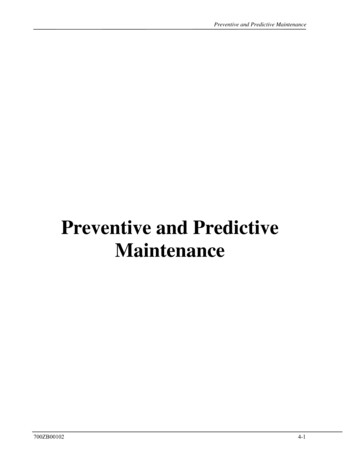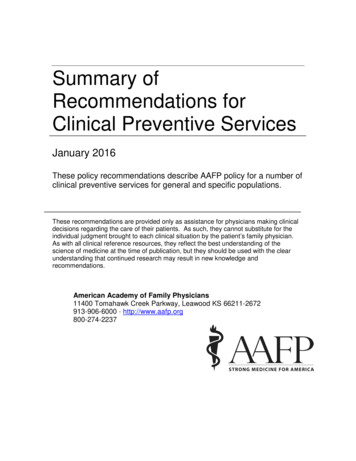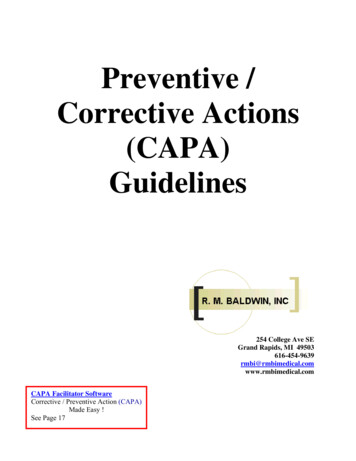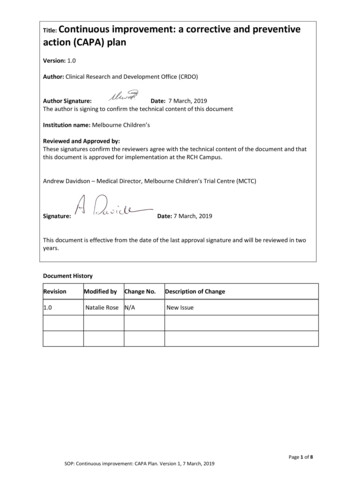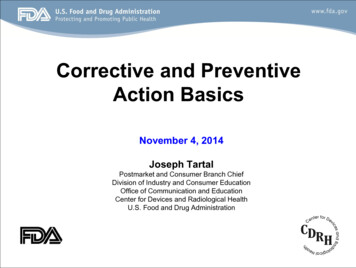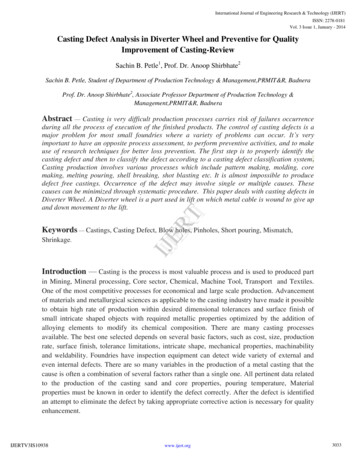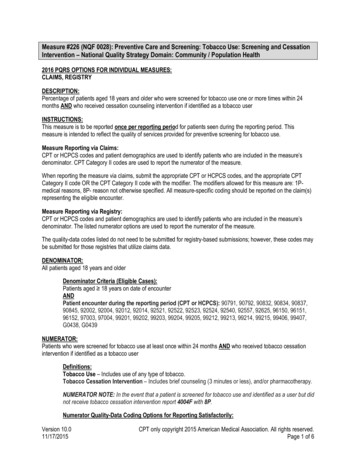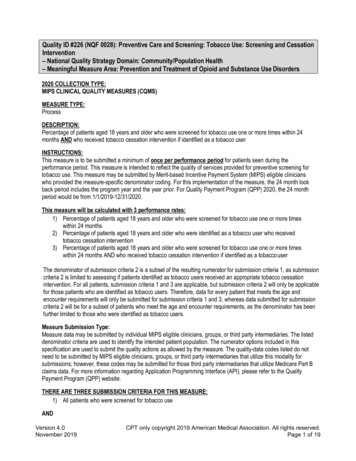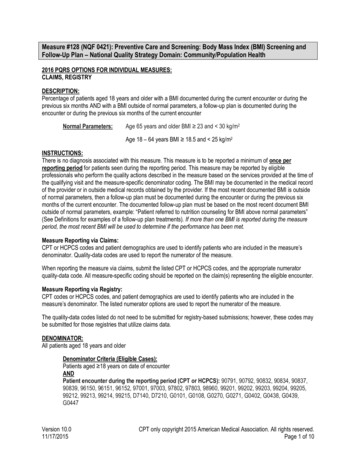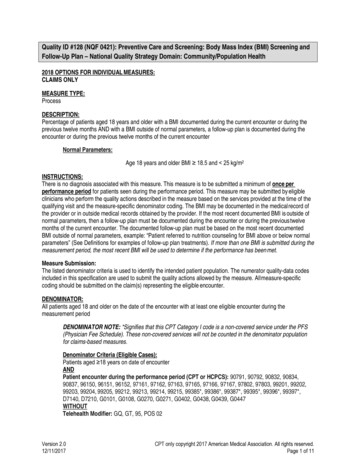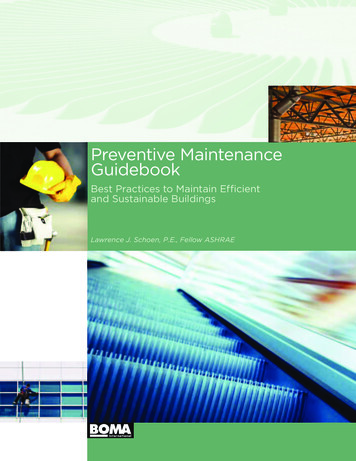
Transcription
Preventive MaintenanceGuidebookBest Practices to Maintain Efficientand Sustainable BuildingsLawrence J. Schoen, P.E., Fellow ASHRAE
PREVENTIVE MAINTENANCE GUIDEBOOKAbout BOMA InternationalFounded in 1907, the Building Owners and Managers Association (BOMA) Internationalis an international federation of more than 100 local associations and affiliated organizations. The 16,500-plus members of BOMA International own or manage more than9 billion square feet of commercial properties in North America and abroad. BOMA’smission is to enhance the human, intellectual and physical assets of the commercialreal estate industry through advocacy, education, research, standards and information.On the Web at www.boma.org.BOMA International has developed this publication as a service to the office building industry and tothe public. Use of this publication is voluntary and should be undertaken after an independent reviewof the applicable facts and circumstances of the particular projects. Although BOMA International hasmade all reasonable efforts to present comprehensive and accurate information, NO GUARANTEESOR WARRANTIES, INCLUDING EXPRESS OR IMPLIED WARRANTIES OF MERCHANTABILITY ORFITNESS ARE MADE WITH RESPECT TO THIS PUBLICATION BY BOMA INTERNATIONAL, ITSOFFICERS, DIRECTORS, EMPLOYEES, OR AGENTS, WHO ALSO ASSUME NO LEGAL RESPONSIBILITY FOR THE ACCURACY OF THE PRESENTATIONS, COMMENTS, OR OTHER INFORMATION INTHIS PUBLICATION. IN ADDITION, NO LIABILITY IS ASSUMED AND ALL LIABILITY IS EXPRESSLYDISCLAIMED FOR NEGLIGENCE OR DAMAGES OF ANY KIND, ANY DECISIONS, CONTRACTS,COMMITMENTS, OBLIGATIONS OR ANY OTHER ACTIONS UNDERTAKEN OR MADE ON THEBASIS OF THE INFORMATION CONTAINED IN THIS PUBLICATION. These documents have important legal and financial consequences, and independent consultation with an attorney and financialadvisor are encouraged with respect to execution or modification. No part of this publication maybe reproduced, recorded or copied in any manner or by any means, in whole or in part, withoutthe prior permission of BOMA International, 1101 15th St., NW, Suite 800, Washington, DC, 20005,202.408.2662 or from other individuals or organizations owning copyright interests in other partsof the publication as identified.Preventive Maintenance Guidebook: Best Practices to Maintain Efficient and Sustainable Buildings 2010 Building Ownersand Managers Association (BOMA) International, Washington, DC. All rights reserved.ISBN # ISBN #978-0-9778587-7-4ii
PREVENTIVE MAINTENANCE GUIDEBOOKForeword to the Third EditionBOMA International is proud to present the Third Edition Preventive Maintenance: Best Practices toMaintain Efficient and Sustainable Buildings, a revision of the 2003 version, Preventive Maintenanceand Building Operation Efficiency. The publication was first issued in 1996 under the title, How toDesign and Manage Your Preventive Maintenance Program.This new edition contains greater emphasis on predictive maintenance, sustainability, commissioning,use of electronic tools and resources, renewable and recovered energy. It contains more checklistsand has an updated peer-reviewed Appendix on Building Systems Useful Life.AcknowledgementsAbout the AuthorThe BOMA International Preventive Maintenance Guidebook: Best Practices to Maintain Efficient andSustainable Buildings is authored by Lawrence J. Schoen, P.E., president of Schoen Engineering, Inc.,an international building services engineering firm based in Columbia, Maryland. Schoen’s experienceincludes engineering management for a commercial developer/operator where he was responsiblefor operation, maintenance and capital improvements to mechanical and electrical systems andenvironmental compliance and risk reduction in 60 million square feet of shopping centers, office/industrial buildings and hotels located throughout the world. He was also a design engineer at one ofthe largest international building services engineering consulting firms. He has conducted DOE-funded energy research at Princeton University’s Center for Energy and Environmental Studies. He has aB.S. in Mathematics from SUNY at Buffalo and an M.S. in Mechanical Engineering from New JerseyInstitute of Technology. He is a licensed Professional Engineer (P.E.) in several States, Fellow ofAmerican Society of Heating, Refrigerating and Air Conditioning Engineers (ASHRAE), OperatingEngineer past Chair Baltimore Section of American Society of Mechanical Engineers (ASME), IEEE,International Society of Indoor Air Quality and Climate (ISIAQ) and International Council of ShoppingCenters (ICSC).Schoen is a voting committee member of ANSI/ASHRAE/USGBC/IES 189.1, Standard for the Designof High-Performance Green Buildings, Chair of ASHRAE’s Environmental Health Committee, chairedits IAQ 2007 Conference, Healthy and Sustainable Buildings, was BOMA’s voting member forStandard 62.1, Ventilation for Acceptable Indoor Air Quality from 1996 to 2008, serves on the ICSCEnergy / Environmental Committee and is ASME’s voting member on the Maryland Department ofthe Environment Air Quality Control Advisory Council.Schoen has published technical articles in the fields of HVAC, IAQ, building maintenance, operationsand energy and has spoken at numerous forums for BOMA International, ASHRAE, the NationalRealty Committee, Associated General Contractors, IAQ Publications and others. He was theauthor of the 2003 BOMA International Preventive Maintenance and Building Operation Efficiencypublication.iii
PREVENTIVE MAINTENANCE GUIDEBOOKThe author and BOMA International would like to acknowledge the participation of the followingindividuals and organizations that assisted with review of the materials in the current and previouseditions of the publication.Raymond Blank, dec’d.R.M. Blank & AssociatesThe Rouse CompanyCommittee of Operating EngineersRon BurtonBOMA InternationalFranklin Dale TilleyState of California Department ofGeneral ServicesDaniel W. Chancey, RPAGrubb & Ellis Management Services, Inc.Jim Coggins, ret’dSelect Energy Services, Inc.Ernie Conrad, P.E.Landmark Facilities Group, Inc.Mary Youngman, RPAAllied PlazaDesignPittny CreativeRoy CookTranswestern Commercial ServicesGee CosperGee Cosper & AssociatesNicholas FioravanteConsolidated EngineeringKen FoldingTrammel Crow CompanyPeter FordGeneral Services AdministrationJim GrossThyssenKrupp Elevator CorporationOmar A. HernandezChief Engineer, Allied PlazaGary MarineTrammel Crow CompanyRocky McPhersonTrammel Crow CompanyGeorge OwensEnergy and Engineering Solutions, Inc.Lisa PratsBOMA InternationalRichard SasseVFA, Inc.Jason StanleyIB Roof SystemsDave StuckyCity of San DiegoBOMA International OfficersChair & CEORay H. Mackey, Jr., RPA, CPM , CCIMStream Realty Partners LPDallas, TXChair-ElectBoyd R. ZoccolaHokanson CompaniesIndianapolis, INVice ChairJoseph P. MarklingCB Richard EllisLos Angeles, CASecretary-TreasurerKent C. Gibson, CPM Property Reserve, Inc.Salt Lake City, UTPublished byBuilding Owners and Managers Association(BOMA) InternationalSuite 8001101 15th Street, N.W.Washington, DC 20005202.408.2662www.boma.orgSteve TaylorTaylor Engineeringiv
PREVENTIVE MAINTENANCE GUIDEBOOKAppendix 7: Building Systems Useful LifeThe following list of systems and average usefullife years is the opinion of the author based onregular preventive maintenance properlyperformed at prescribed frequencies. Manyfactors can affect the average useful life andlike any average, individual systems andcomponents will have lifetimes far from average. Lifetimes can often be extended significantly through robust maintenance programsthat go beyond the norm, and many facilitiescurrently have functioning equipment olderthan the lifetimes listed.Climatic conditions and challenging environments (for instance in wet locations, near saltwater or heavy industry) will shorten life.Selection of heavy-duty equipment features,such as hinged access doors, double wallpanels, serviceable components, corrosionresistant materials and other factors willlengthen life.Due to hardware and software revisions, centralcontrol equipment for HVAC, fire alarms,security and other computerized systems canbecome “orphaned” and no longer supportedby vendors. Users may consider new orenhanced functionality essential and thesemay be compatible only with new hardwareand software. Vendors have incentives to forceupgrades. Any of these factors can shortenthe useful life of central control hardware andsoftware.Despite all the limitations of averages, this listserves as a general guide for future planning.Energy cost reduction may justify replacementor major upgrade of equipment prior to the endof its useful life.6SYSTEMSAVERAGE USEFULLIFE YEARSA. HVAC61. Air Conditionersa. Window Unitb. Residential Single or Split Packagec. Commerciald. Water-Cooled Packagee. Computer Room Unit10151020152. Air Handling Unitsa. Built-Up Heavy Dutyb. Packaged Medium-Dutyc. Severe Duty or 100% Outside Air3025203. Heat Pumpsa. Residential Air-to-Airb. Commercial Air-to-Airc. Commercial Water-to-Air1215184. Roof-Top Air Conditionersa. Single Zoneb. Multizonec. VAV1818205. Boilers, Hot Waterb. Steel Water-Tubec. Steel Fire-Tubed. Cast Irone. Electricf. Condensing30303025156. Boilers, Steama. Steel Water-Tubeb. Steel Fire-Tubec. Cast Iron2825307. Burners188. Furnacesa. Gas Firedb. Oil Firedc. Condensing1818159. Unit Heatersa. Gasb. Electricc. Hot Waterd. Steam1315202010. Heatersa. Electric Radiant or Convectorb. Radiant Hot Waterc. Radiant Gasd. Steam or Hot Water Convector,Cast Irone. Steam or Hot Water Fin Tube1025185015HVAC Equipment life is based on approximately 3500 operating hours, 1800 equivalent full load hours use/year and a normalamount of on-off cycles. This is equivalent to 21 percent annual average load factor. More hours of use/year and more frequentcycling will decrease lifetime.76
PREVENTIVE MAINTENANCE GUIDEBOOKSYSTEMSAVERAGE USEFULLIFE YEARS11. Air Terminalsa. Diffusers, Grilles, Registers,Heavy Gauge, Coatedb. Diffusers, Grilles, RegistersPerforated or Light Gaugec. Induction Unitsd. Fan-Coil Unitse. VAV Boxes Cooling Onlyf. CAV Boxesg. Double Duct Boxesh. Fan Powered VAV Boxesi. Variable Volume Temperature Boxes3520252525171512. Air Washers & Humidifiersa. Sprayb. Steamc. Pan, Wheel or Wetted Element1215813. Ductworka. Galvanized Steel, Aluminumand Black Ironb. Fiberglassc. Flexible Round301530151014. Dampersa. Operable or Automatic20b. Fixed (balancing) or Fusible Link (fire) 3015. Fansa. Centrifugalb. Axialc. Propellerd. Ventilating Roof-Mounted,Mild Exhauste. Kitchen or Other Soiled Exhaust252015201516. Coils—Fluid to Aira. Direct Expansion (refrigerant)b. Water/Steam Heatingc. Cooling and Dehumidifyingd. Electric1820121217. Heat Exchangersa. Commercial—Shell and Tubei. Steam to Domestic Waterii. Steam to Heating Wateriii. Water to Domestic Wateriv. Water to Waterb. Residential Immersion Coilc. Plate and Framed. Energy Recovery Wheele. Energy Recovery Waterf. Energy Recovery Air to Airg. Energy Recovery Heat Pipe1320152525251512122018. Reciprocating Air Compressors15SYSTEMSAVERAGE USEFULLIFE YEARS19. Package Chillers7a. Reciprocatingb. Centrifugalc. Absorptiond. Screwe. Scroll202030201520. Cooling Towersa. Galvanized or Coated Steelb. Woodc. Ceramicd. Fiberglasse. Stainless Steelf. Fill Media18203535251521. Condensersa. Air-Cooledb. Evaporative201522. Insulation (not subject tocondensation or leaks)a. Moldedb. Blanket202523. Pumpsa. Base Mountedb. In-linec. Sump-Submergedd. Well-Submergede. Condensate251510101524. Reciprocating Enginesa. Continuous Serviceb. Back-Up Service52025. Steam Turbines3026. Electric Motorsa. Without Soft Startb. With Soft Start182527. Motor Startersa. In Dry Noncorrosive Areasb. In Wet or Corrosive Areas(cooling towers)251028. Electric Transformersa. Oil-Filledb. Dry Type303029. Controllersa. Pneumaticb. Electricc. Electronicd. Computer Front End Controls81820201530. Valve and Damper Actuatorsa. Hydraulicb. Pneumaticc. Motorized Electricd. Self-Contained152018107Chillers using CFCs, especially R-12 may require replacement or significant upgrade before the end of their life due to refrigerantunavailability. Chillers using HFCs such as R-123 are expected to have access to an active market of recycled refrigerant. Companieswith large inventories of equipment can get full service life of existing equipment by “banking” their own refrigerants reclaimedfrom retired equipment in accordance with EPA and other regulations.8See note at top of this list regarding shortened useful life of central control hardware and software.77
PREVENTIVE MAINTENANCE GUIDEBOOKSYSTEMSAVERAGE USEFULLIFE YEARS31. Control Sensorsa. Temperatureb. Humidity, CO2c. Water Flowd. Air Flow32. Heating and Cooling Piping Systema. Above Groundb. Ground Source HeatExchange Loops205510304033. Oil Storage Tank with CorrosionProtectiona. Above Groundb. Undergroundc. Underground: FRP Coated Steel25203034. Boiler Chimneys and Fluesa. Metal Flue and Breechingb. Steel Chimneyc. Masonry Chimney203050B. ELEVATOR/ESCALATOR1. Elevator9a. Hydraulici) Underground CylinderDry Locationii) Car and Pump Unitb. Traction10c. Geared Tractiond. Cab Interior Finishe. Carpet355035100.52. Escalatora. In Dry Location Not For Mass Transitb. In Wet Location or For Mass Transit40203. Controllersa. Electromechanical Relay Based11b. Computer Based30204. Elevator Door Operatorsa. Passengerb. Freight or Service Used For Carts20105. Wheelchair and Stairway Chair Lift2515AVERAGE USEFULLIFE YEARS2. Flush Valves123. Fixtures: Commerciala. Faucetsb. Water Closetsc. Urinalsd. Sinkse. Refrigerated Drinking Fountain7303030154. Pumpsa. Base Mountedb. In-linec. Sewage Ejectord. Sump-Submerged or Pedestale. Well-Submerged25151010105. Backflow Preventiona. Light Dutyb. Heavy Duty (Main Service)10306. Domestic Water Piping Systemsa. Hot and Cold Water (Copper or Plastic) 30b. Waste Piping (PVC or Cast Iron)30c. Kitchen Waste207. Gas Piping Systemsa. Fuel Gas Threadedb. Fuel Gas Weldedc. Medical Gasd. Compr
BOMA’s mission is to enhance the human, intellectual and physical assets of the commercial real estate industry through advocacy, education, research, standards and information. On the Web at www.boma.org. BOMA International has developed this publication as a service to the office building industry and to the public. Use of this publication .File Size: 671KBPage Count: 9

